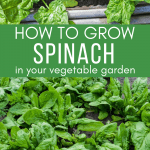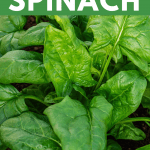How To Plant, Care For & Harvest Spinach In Your Vegetable Garden
From starting spinach seeds to harvesting, we share the best tips for growing your own spinach. Whether you have raised garden beds or containers, growing spinach is easy and you can enjoy a successful spinach harvest with these expert tips.

Disclosure: This post contains affiliate links, which means if you make a purchase through these links, we may receive a small commission at no extra cost to you.
As far as greens go, spinach is probably the most versatile in recipes, in my opinion. It’s packed with nutrients and you can toss it in salads, blend it up in smoothies and easily add it to stir fries and soups. Garden spinach has an amazing fresh flavor in salads, but it also has a fairly mild taste, so you can sneak it in smoothies and other recipes to add nutrition for picky eaters.
Spinach is one of the earliest crops you can plant in your garden. Read more at When To Plant Seeds In Your Vegetable Garden.
Planting Spinach
Spinach is a cool weather crop that can tolerate some frost, but is not very tolerant of hot and dry conditions.
Prepare the soil by adding compost and organic fertilizer. Since you want to encourage leafy growth we recommend a fertilizer high in nitrogen (e.g. blood meal).
Seed You can direct seed spinach in your garden about 4 weeks before your average last frost. You can also start plants indoors, but spinach grows rapidly in the garden so we don’t bother to start them inside.
Maximize yields We don’t plant our spinach seeds in rows. Instead we broadcast seeds very densely over a designated section of our raised beds. You’ll see why in the video and harvest section below.
Spacing Final spacing for spinach should be 4-6 inches.
Tip We extend our spinach harvest by starting the first sowing in a hoop tunnel 6-7 weeks before last frost. We also plant a second crop about three weeks after the first in an area of the garden that receives a little bit of shade. The second crop never lasts as long as the first, but it does extend our harvest by a couple of weeks at least.
In the video below, Jeremy shows you our planting strategy for lettuce, but the same planting and harvesting strategy applies to spinach as well.
Caring For Spinach
- Soil: Mulch with straw or other organic matter to keep soil moist and reduce soil temperatures.
- Sun: Spinach does well in full sun but can also tolerate some shade. Our dense planting method means that the plants form a living mulch that keeps the soil cool and moist. As we thin out plants we put down straw mulch to conserve moisture and keep soil temperature down.
- Supplement: We fertilize with liquid organic fertilizer high in nitrogen once a month to encourage leafy growth.
- Heat: The main thing to worry about with spinach is heat. As soon as summer heat arrives, the plants begin to bolt (flower). Anything you can do to protect the plants from heat (e.g. shade cloth during the hottest parts of the day) will extend the growing season by a little bit.
- Pests: Spinach plants are attacked by the same leafmining fly that also attacks beets and Swiss chard. If you see “tunnels” in the leaves of your spinach, you know the fly is around. Since you want to eat the leaves, this pest can cause considerable damage to your crop. Immediately remove any leaves with evidence of mining so the fly cannot complete its lifecycle. Dispose of the leaves in the trash instead of leaving them in the garden. If you have a small spinach crop you can manually remove eggs from the underside of leaves each morning. They are easily seen by turning the leaf over and looking for a neat row of several white eggs. If you smash them before the larvae hatch they will not do any damage to the plant. This approach can be tedious, so we have the best success by keeping spinach covered throughout the growing season with lightweight floating row covers. Just make sure to put the row covers down early, before you have any flies in the garden. We recommend the lightest row covers you find, since they will trap some heat, which shortens the growing season.

Harvesting Spinach
You have a few options for harvesting spinach. As explained in the video below, to maximize yields we thin by harvesting whole plants when they are at the size of baby greens. When plants are at final spacing, you can harvest outer leaves over a period of several weeks.
Spinach does not last long in summer heat, so once you start to see the first signs of bolting (the leaves change from oval to arrowhead shape, the plants grow taller and send up stalks with small clusters of flower buds) it’s best to harvest the entire plant. If you wait too long the leaves will become tough and taste bitter.
Our Favorite Spinach Varieties
All varieties we have tried have excellent flavor. The main important difference is how quickly the plants bolt. The best variety we have trialed in this regard is ‘Tyee’. We also plant ‘Space,’ which is delicious and almost as bolt resistant as ‘Tyee’. ‘Reflect’ is another variety of spinach with excellent flavor that doesn’t bolt as quickly as some of the other varieties we’ve tried.
More Gardening Inspiration
images via depositphotos




